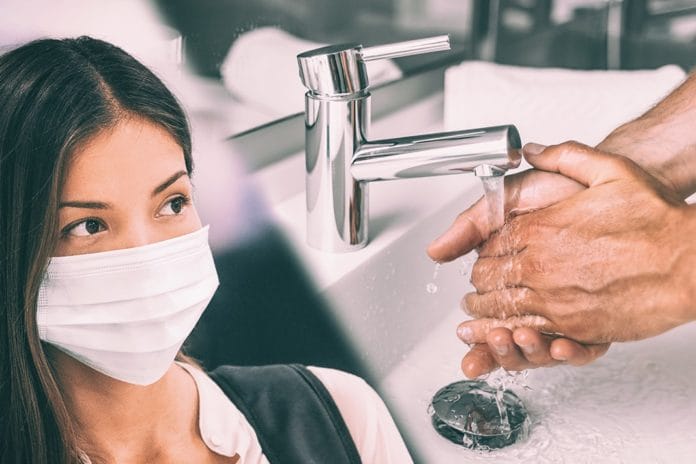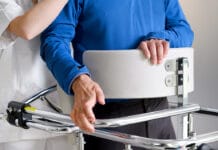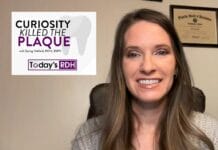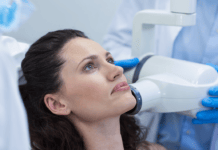Editor’s Note: Information about COVID-19 is changing on a daily, sometimes hourly, basis. We have made every attempt to ensure this article is up-to-date at the time of publication, but with the rapid changes occurring, some information may have changed since publication. Please visit https://www.coronavirus.
On February 11, 2020, the World Health Organization announced an official name for the disease that is causing the 2019 novel coronavirus outbreak, first identified in Wuhan, China. The new name of this disease is coronavirus disease 2019, abbreviated as COVID-19.
Formerly, this disease was referred to as “2019 novel coronavirus” or “2019-nCoV.” There are many types of human coronaviruses, including some that commonly cause mild upper-respiratory tract illnesses. COVID-19 is a new disease caused by a novel (or new) coronavirus that has not previously been seen in humans.1
This virus was first detected in Wuhan City, Hubei Province, China. The first infections were linked to a live animal market, but the virus is now spreading from person-to-person. It’s important to note that person-to-person spread can happen on a continuum. Some viruses are highly contagious (such as measles), while other viruses are less so.1
At the time of this writing, March 3, 2020, coronavirus has killed more than 3,100 people, the vast majority in mainland China. There are now over 90,000 global cases, with infections in more than 70 countries and territories.2 The ninth death from COVID-19 has been confirmed in the United States. The eighth and ninth persons confirmed to have died in the U.S. from the coronavirus lived in Washington state, just like the previous seven victims. Washington accounts for almost 27 of the 108 cases so far reported in the U.S., and state officials said 231 people are under public health supervision.3
Protection Offered by Masks
There is a great concern over this virus, and as health-care providers, we need to be aware of the current recommendations from the Center for Disease Control and Prevention (CDC), Occupational Safety and Health Administration (OSHA), and the American Dental Association (ADA) in order to keep ourselves and our patients healthy and limit the possible transmission of any virus.
Currently, the transmission of the disease is still under investigation, but the CDC recommends treating it as an airborne pathogen for health-care workers directly caring for COVID-19 patients. That means health-care workers interacting with a coronavirus patient should wear a heavy-duty mask called an N95 respirator. These respirators are designed to fit tightly around the nose and mouth, and, when worn correctly, block out at least 95% of small airborne particles.4
In comparison, surgical masks are used as a physical barrier to protect the user from hazards, such as splashes of large droplets of blood or body fluids. Surgical masks also protect other people against infection from the person wearing the surgical mask. Such masks trap large particles of body fluids that may contain bacteria or viruses expelled by the wearer.
Surgical masks are used for several different purposes, including on sick people to limit the spread of infectious respiratory secretions to others, worn by health-care providers to prevent accidental contamination of patients wounds by the organisms present in mucus and saliva, and worn by workers to protect themselves from splashes or sprays of blood or bodily fluids. They may also keep contaminated fingers/hands away from the mouth and nose.5 At the present time, there has been a limit on the number of masks able to be ordered through dental supply companies due to an increase in demand.
Reusing of Masks
Due to mask shortages, some offices are limiting the number of masks for providers and even telling employees to reuse masks. This is not acceptable. If an item states “single use” that means it is only to be used once, then discarded, no exceptions. It is imperative to be following manufacturers’ instructions for use for all products we use. The CDC states, “A single-use device, also called a disposable device, is designed to be used on one patient and then discarded, not reprocessed for use on another patient.9”
According to the CDC, “The mask’s outer surface can become contaminated with infectious droplets from spray of oral fluids or from touching the mask with contaminated fingers. Also, when a mask becomes wet from exhaled moist air, the resistance to airflow through the mask increases, causing more airflow to pass around edges of the mask. If the mask becomes wet, it should be changed between patients or even during patient treatment, when possible.9” For instance, when working in a highly aerosolized environment, such as using an ultrasonic scaler, after 20 minutes, the mask should be changed as it may not be effective anymore due to moisture.
Further, OSHA requires all employers to protect employees from workplace hazards, provide a safe workplace, and provide proper PPE to employees. This includes masks. OSHA states, “When there is occupational exposure, the employer shall provide, at no cost to the employee, appropriate personal protective equipment such as, but not limited to, gloves, gowns, laboratory coats, face shields or masks and eye protection, and mouthpieces, resuscitation bags, pocket masks, or other ventilation devices. Personal protective equipment will be considered “appropriate” only if it does not permit blood or other potentially infectious materials to pass through to or reach the employee’s work clothes, street clothes, undergarments, skin, eyes, mouth, or other mucous membranes under normal conditions of use and for the duration of time which the protective equipment will be used.10”
If an employer does not abide by OSHA requirements, OSHA should be notified. After investigation, if an office is found guilty, hefty fines for violations may occur. Just one example of a dental office with two locations, who was found in violation of OSHA’s bloodborne pathogen exposure standards in 2016, was required to pay $53,900 in fines.11
Standard Precautions
Dental professionals should adhere to the guidelines and recommendations outlined in an informational handout released by the ADA. “The use of standard precautions within the dental workplace and acquiring a thorough history of symptoms and potential exposure for patients is critical for dental health care professionals to maintain a healthy working environment, whether the concern is flu, 2019-nCoV or other transmissible illnesses,” said Dr. Maria Geisinger, chair of the ADA Council on Scientific Affairs.6
Standard precautions include:
1) Hand hygiene.
2) Use of personal protective equipment (gloves, masks, eyewear).
3) Respiratory hygiene/cough etiquette.
4) Sharps safety (engineering and work practice controls).
5) Safe injection practices (i.e., aseptic technique for parenteral medications).
6) Sterile instruments and devices.
7) Clean and disinfected environmental surfaces.7
In addition, obtaining a thorough travel and health history is vital in helping to identify any potential patients that could be at risk for COVID-19. Offices should consider postponing nonemergency dental care to patients within 14 days of travel from China. When confirming appointments, offices should consider having a dialogue with patients about any health changes or recent travel.
For safety’s sake, reschedule any patients who present with any flu-like symptoms to help prevent spreading communicable diseases. At present, there is no vaccine for the COVID-19 virus. Being intentional about avoiding big crowds of people (especially if you are over 60 years old), do not touch your eyes, mouth or nose with unwashed hands. When you do wash your hands, use soap and water for at least 20 seconds after contact with patients. An alcohol-based hand sanitizer with 60% alcohol is acceptable if soap and water are not readily available. Stay home if you are sick, cover your sneezes and coughs with a tissue and dispose of it in the trash, clean and disinfect frequently touched surfaces and objects.8
Our profession has its variety of challenges and occupational hazards, this COVID-19 is just the newest. Be vigilant, intentional, and follow the CDC and ADA recommendations until we have a better understanding of this disease and, ultimately hopefully, a vaccine. Stay safe out there!
Now Listen to the Today’s RDH Dental Hygiene Podcast Below:
References
- Coronavirus Disease 2019 (COVID-19). Centers for Disease Control and Prevention. March 3, 2020. Retrieved from https://www.cdc.gov/coronavirus/2019-ncov/faq.html#basics.
- Westcott, B., Renton, A., John, T., Hayes, M., Wagner, M. March 3 Coronavirus News. CNN. March 3, 2020. Retrieved from https://www.cnn.com/asia/live-news/coronavirus-outbreak-03-03-20-intl-hnk/index.html.
- Bacon, J., Ortiz, J.L. Coronavirus Live Updates: 9th U.S. Death is Confirmed as WHO Rejects Pandemic. USA Today. March 3, 2020. Retrieved from https://www.usatoday.com/story/news/health/2020/03/03/coronavirus-live-updates-covid-19-california-cdc-numbersdeaths/4929223002/.
- Godoy, M. Face Masks: What Doctors Say about Their Role in Containing Coronavirus. NPR. January 29, 2020. Retrieved from https://www.npr.org/sections/goatsandsoda/2020/01/29/800531753/face-masks-what-doctors-say-about-their-role-in-containing-coronavirus.
- Respiratory Infection Control: Respirators Versus Surgical Masks. United States Department of Labor, Occupational Safety and Health Administration. Retrieved from https://www.osha.gov/Publications/respirators-vs-surgicalmasks-factsheet.html.
- Versaci, M.B. CDC Reminds Clinicians to Use Standard Precautions, Recommends Isolating Patients with Coronavirus Symptoms. American Dental Association. February 7, 2020. Retrieved from https://www.ada.org/en/publications/ada-news/2020-archive/february/cdc-recommends-isolating-patients-with-coronavirus-symptoms.
- Standard Precautions. Centers for Disease Control and Prevention. Retrieved from https://www.cdc.gov/oralhealth/infectioncontrol/summary-infection-prevention-practices/standard-precautions.html.
- CDC to Offer Coronavirus Guidance during Webinar Jan. 31. American Dental Association. Retrieved from https://www.ada.org/en/publications/ada-news/2020-archive/january/cdc-to-offer-coronavirus-guidance-during-webinar-jan-31.
- Kohn, W.G., Collins, A.S., Cleveland, J.L., Harte, J.A., Eklunt, K.J., Malvitz, D.M. Guidelines for Infection Control in Dental Health-Care Settings – 2003. Center for Disease Control and Prevention. MMWR 2003; 52 (Report No. 17). Retrieved from http://www.cdc.gov/mmwr/PDF/rr/rr5217.pdf
- 1910.1030 Bloodborne Pathogens. US Department of Labor – Occupational Safety & Health Administration. Retrieved from http://www.osha.gov/pls/oshaweb/owadisp.show_document?p_table=STANDARDS&p_id=10051
- OSHA News Release – Region 5. US Department of Labor – Occupational Safety & Health Administration. Retrieved from https://www.osha.gov/news/newsreleases/region5/07052016











